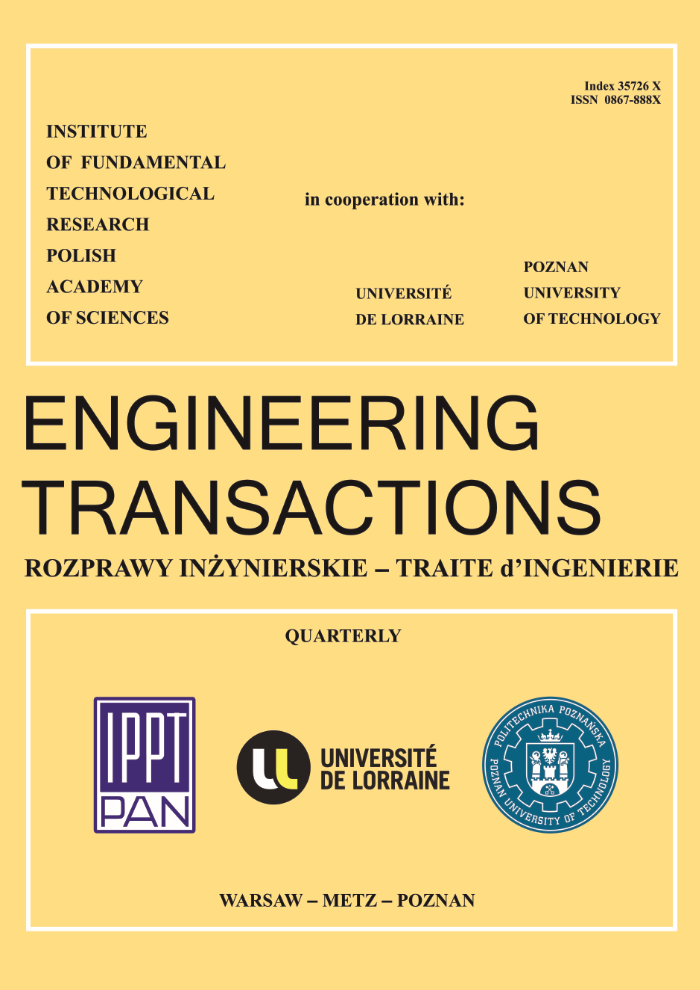Evaluation of Dynamic Compressive Properties of Pla/Pbat Polymer Alloys Using Split Hopkinson Pressure Bar Method
Abstract
Poly(lactic acid) (PLA) is a biodegradable biomass polymer. Polymer blends or polymer alloys have been used to overcome its brittleness. Because poly(butylene/adipate/terephthalate) (PBAT) is a ductile and biodegradable polymer, PLA/PBAT polymer alloys can potentially exhibit high impact strengths. Different mixing ratios of PLA/PBAT (80:20, 70:30 and 60:40) and the addition of dialkylperoxide as compatibilizing agent for each mixing ratio have been examined. The stress-strain curves of the PLA/PBAT specimens (observed using a scanning electron microscope) were measured using a split Hopkinson pressure bar (Kolsky bar) and a universal testing machine. The PBAT ratios and addition of dialkylperoxide affected the stress-strain curves. Yield stress decreased with increasing PBAT ratios. Addition of dialkylperoxide did not change the yield stress of specimens when PLA:PBAT = 80:20. At high strain rates, the addition of dialkylperoxide clearly reduced yield stress and Young’s modulus when PLA: PBAT = 70:30 and 60:40.References
1. H. Tsuji, Y. Ikada, Blends of Aliphatic Polyesters. 1. Physical Properties and Morphologies of Solution-cast Blends from Poly(DL-lactide) and Poly(epsilon- caprolactone), Journal of Applied Polymer Science, 60, 13, 2367–2375, 1996.
2. C.-C. Chen, J.-Y. Chueh, H. Tseng, H.-M. Huang, S.-Y. Lee, Preparation and Characterization of Biodegradable PLA Polymeric Blends, Biomaterials, 24, 1167–1173, 2003.
3. M. Todo, S.-D. Park, T. Takayama, K. Arakawa, Fracture Micromechanisms of Bioabsorbable PLLA/PCL Polymer Blends, Engineering Fracture Mechanics, 74, 12, 1872–1883, 2007.
4. M. Nishida, M. Yamaguchi, M. Todo, T. Takayama, H.-A Haggblad, P. Jons´en, Evaluation of Dynamic Compressive Properties of PLA Polymer Blends Using Split Hopkinson Pressure Bar, [in:] Proceedings of DYMAT 2009, 1, 909–915, 2009.
5. N. Fukuda, H. Matsubara, R. Kitagawa, The Crystallization Behaviors and Mechanical Properties of Poly(lactic acid)/Poly(butylenes adipate terephthalate) Alloys, [in:] Proceedings of 59th Symposium on Macromolecules, pp. 5657–5658, 2007 (in Japanese).
6. F. Signori, M.-B. Coltelli, S. Bronco, Thermal Degradation of Poly(lactic acid) (PLA) and Poly(butylenes adipate-co-terephthalate) (PBAT) and Their Blends Upon Melt Processing, Polymer Degradation and Stability, 94, 74–82, 2009.
7. G. T. Gray III, Classic Split Hopkinson Pressure Bar Testing, [in:] ASM Handbook Vol. 8, Mechanical Testing and Evaluation, ASM, 462–476, 2000.
8. K. Nakai, T. Yokoyama, Strain Rate Dependence of Compressive Stress-Strain Loops of Several Polymers, Journal of Solid Mechanics and Materials Engineering, 2, 4, 557–566, 2008.
2. C.-C. Chen, J.-Y. Chueh, H. Tseng, H.-M. Huang, S.-Y. Lee, Preparation and Characterization of Biodegradable PLA Polymeric Blends, Biomaterials, 24, 1167–1173, 2003.
3. M. Todo, S.-D. Park, T. Takayama, K. Arakawa, Fracture Micromechanisms of Bioabsorbable PLLA/PCL Polymer Blends, Engineering Fracture Mechanics, 74, 12, 1872–1883, 2007.
4. M. Nishida, M. Yamaguchi, M. Todo, T. Takayama, H.-A Haggblad, P. Jons´en, Evaluation of Dynamic Compressive Properties of PLA Polymer Blends Using Split Hopkinson Pressure Bar, [in:] Proceedings of DYMAT 2009, 1, 909–915, 2009.
5. N. Fukuda, H. Matsubara, R. Kitagawa, The Crystallization Behaviors and Mechanical Properties of Poly(lactic acid)/Poly(butylenes adipate terephthalate) Alloys, [in:] Proceedings of 59th Symposium on Macromolecules, pp. 5657–5658, 2007 (in Japanese).
6. F. Signori, M.-B. Coltelli, S. Bronco, Thermal Degradation of Poly(lactic acid) (PLA) and Poly(butylenes adipate-co-terephthalate) (PBAT) and Their Blends Upon Melt Processing, Polymer Degradation and Stability, 94, 74–82, 2009.
7. G. T. Gray III, Classic Split Hopkinson Pressure Bar Testing, [in:] ASM Handbook Vol. 8, Mechanical Testing and Evaluation, ASM, 462–476, 2000.
8. K. Nakai, T. Yokoyama, Strain Rate Dependence of Compressive Stress-Strain Loops of Several Polymers, Journal of Solid Mechanics and Materials Engineering, 2, 4, 557–566, 2008.






